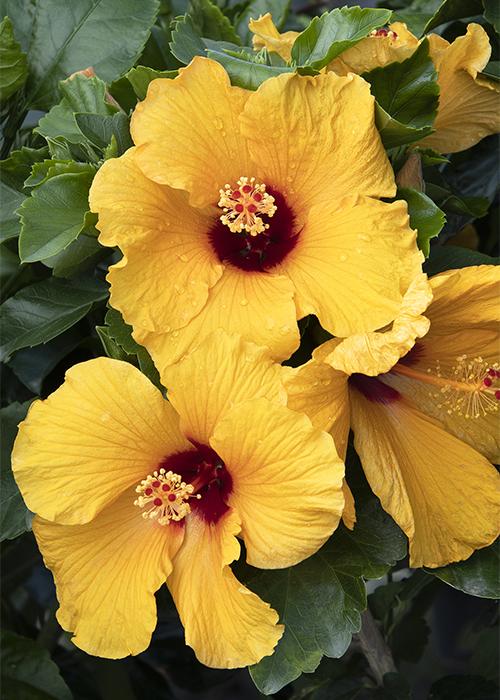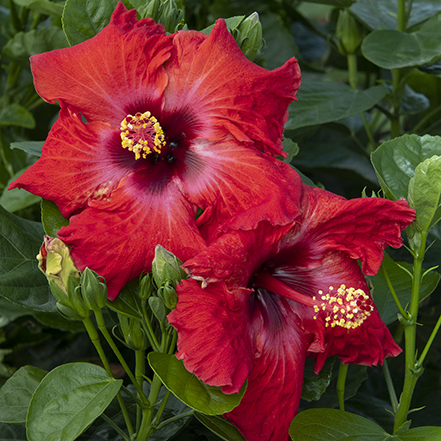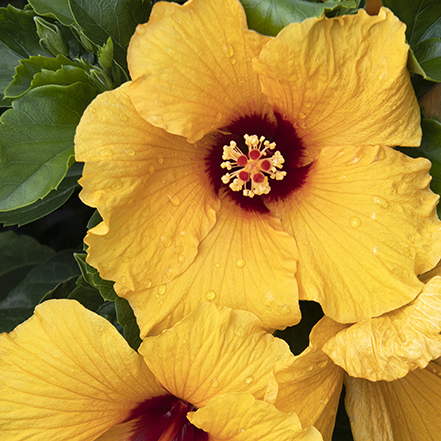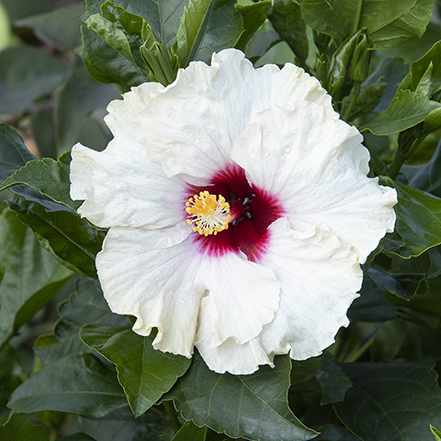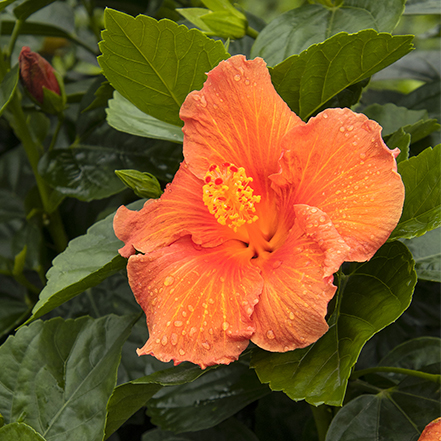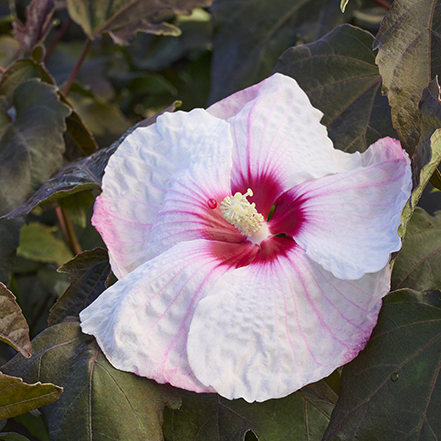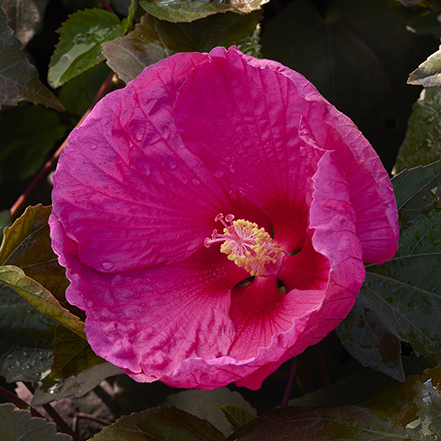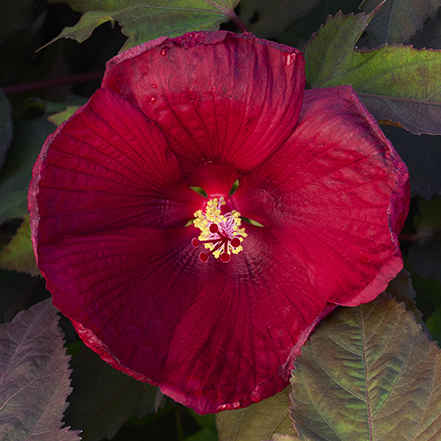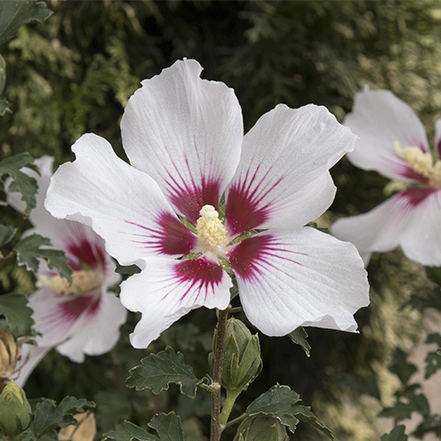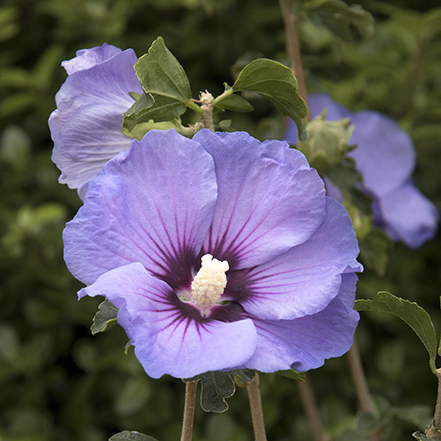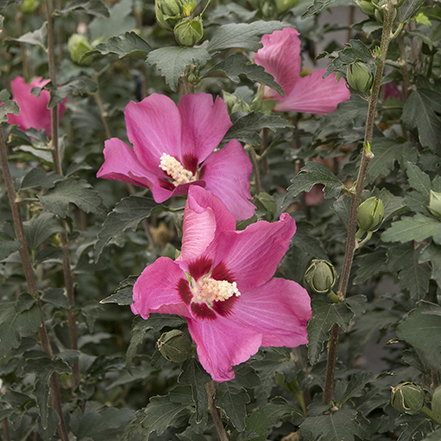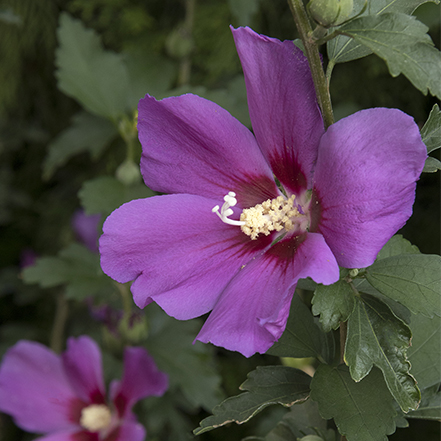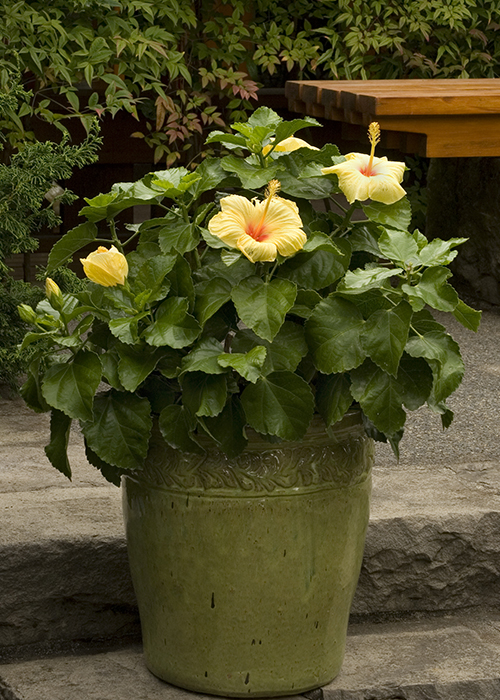Hibiscus brings exotic flair and big color to the garden. Their showy flowers and glossy leaves are perfect for anyone looking to add a pop of color. This member of the mallow family (Malvaceae) has over 30 species native to North America. This consists of both woody and herbaceous plants. Some of the more well-known Hibiscus species grow in tropical climates. However, you can find many other species in colder regions of the U.S.—all the way down to Zone 4. Regardless of your location, you can find a hibiscus that will bring that bold, tropical style to your garden.
This complete hibiscus growing guide covers everything you need to know about growing and caring for hibiscus. From fertilizing to watering, and even how to grow them in containers and indoors.
Hibiscus Care: At A Glance
Short on time? Here's a quick overview of hibiscus care essentials:
- Light: Full sun in northern locations; filtered sunlight in southern areas
- Soil: Well-draining, fertile soil rich in organic matter
- Water: Keep soil consistently moist but not waterlogged
- Temperature: Optimal range 65-85°F; protect from frost
- Fertilizer: Apply balanced fertilizer regularly during the growing season
- Pruning: Trim in late winter or early spring to encourage growth
- Pests: Monitor for aphids, mealybugs, and Japanese beetles
- Winter Care: Bring tropical varieties indoors when temperatures drop below 50°F
- Container Growing: Use high-quality potting mix; repot every few years
- Blooming: Flowers last 1-2 days; remove spent blooms to encourage more flowers
Remember, specific care may vary slightly depending on the hibiscus variety and your local climate.
Hibiscus Types and Favorite Varieties
Before we can begin with the care details, we need to outline the most common hibiscus types. Then, you'll know what to look for to meet your needs in your specific garden. The following plant list includes the top performers in each category to help with your next hibiscus hunt at your local garden center.
Tropical Hibiscus
Tropical Hibiscus (Hibiscus rosa-sinensis) is a medium-sized shrub that typically reaches 5' tall in the landscape. In warm climates (Zone 9-11), Tropical Hibiscus can be grown outside year-round, creating a tropical accent in the garden. They are effective as a hedge or a specimen planting. Regardless of their growing zone, many gardeners use them in containers for patios and courtyards. Growing them in containers allows the incredible flowers to stand out in the garden. (Get tips for growing them in containers further down).
Many growers train these shrubs into a tree shape, adding to their unique look. They are a fantastic choice for adding bold color and a resort-like, tropical feel to an outdoor space.
Tropical Hibiscus favorite: Jazzy Jewel® (Zones 9-11)
An excellent selection of tropical hibiscus that's exclusive to Monrovia. Jazzy Jewel® produces a prolific amount of large, bright flowers. The incredibly long-lasting blooms and dark-green foliage contrast to create an eye-catching combination. A beautiful way to add bold, exotic flair to a patio, balcony, or courtyard. Up to 5' tall and wide in the landscape where hardy (smaller when grown as an annual or in a container). Zones 9-11.
Hardy Hibiscus
If you garden in a cold climate, consider growing hardy hibiscus for a return of bright, bold flowers each year. While the tropical hibiscus is a woody shrub, hardy Hibiscus grows as an herbaceous perennial. It dyes back to the ground each winter. This perennial hibiscus slowly emerges in spring but quickly grows to 4' tall in early summer. The plants reward your patience with clusters of massive blooms the size of dinner plates.
You can grow several species of hardy hibiscus in a wide range of zones. Still, the most common species is Hibiscus moscheutos, which is native to the central United States. To get the maximum effect of these plants, consider planting them as single specimens. Or, in small groups in a visible area of your landscape. You can plant spring-blooming bulbs around your Hibiscus to fill in the space until the plant comes out of dormancy. Once the bulbs bloom, the Hibiscus will emerge and cover up the bulb foliage.
Hardy Hibiscus Favorite: Head Over Heels® (Zones 4-10)
This series of Hardy Hibiscus is stunning! These show-stopping plants feature shades of white, pink, and red flowers. All against a backdrop of burgundy foliage, making them ideal for cottage gardens and borders. Up to 2' tall, 4' wide. Zones 4-10.
Rose of Sharon
Better known as Rose of Sharon, this cold-hardy hibiscus (Hibiscus syriacus) is a shrub with a woody structure. It's perfect for Zones 5-9 and can grow up to 10' tall. Rose of Sharon is more tolerant of poor soils and drier conditions than other hibiscus types. It's the perfect option for gardens that don't have the ideal moist, rich soil that other hibiscus types love.
They're perfect for creating a privacy hedge or as a large specimen shrub that can anchor a garden with its size and colorful flowers. It takes a while for Rose of Sharon to leaf out in spring. Patience is required, but the reward is well worth the wait. Rose of Sharon treats you to the showy blooms that hibiscus is known for, making this shrub stunning in a northern landscape.
Rose of Sharon Favorite: Chateau™ (Zones 5-9)
Breeders have created new varieties of this plant in recent years. Thus giving you more options for flower color and plant size. If you're looking for a Rose of Sharon with a big impact, consider the Chateau™ series. This is named after the Loire Valley in France. These enchanting plants are covered in showy flowers from top to bottom from early summer to fall.
This exclusive Rose of Sharon series offers various flower colors, including Chateau™ de Versailles, featuring blue-violet blooms. You will also find varieties with shades of pink and purple flowers (see them below). Up to 6' tall and 4' wide. Zones 5-9.
How To Grow Hibiscus
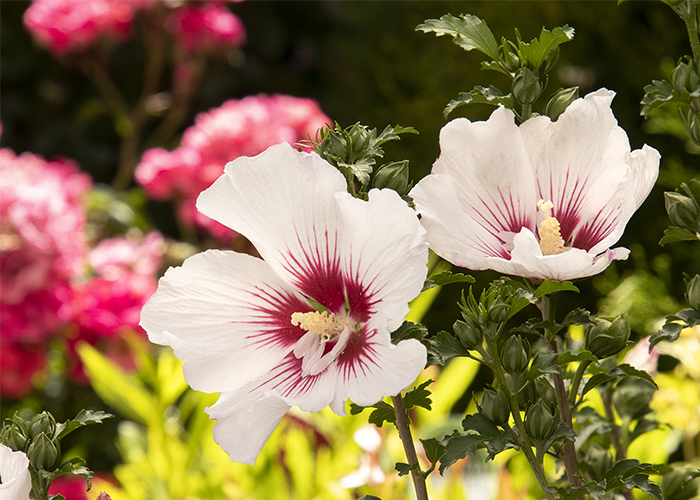
What Conditions Do Hibiscus Plants Need to Thrive?
Proper spacing, watering, and pest control are essential for growing healthy and vibrant hibiscus plants. Understanding these aspects will help you create the ideal environment for your hibiscus to thrive.
Space
Proper spacing is critical for growing any plant. Different hibiscus varieties have different space requirements:
- Tropical Hibiscus: Grows up to 5' tall and wide in the landscape. Space plants about 5' apart when planting.
- Hardy Hibiscus: Reaches 3-4' tall and wide. Space plants 3-4' apart when planting.
- Rose of Sharon: Can get much larger than Tropical and Hardy Hibiscus, sometimes growing up to 8 ft wide, depending on the variety. Therefore, you should space them further apart compared to other hibiscus.
Some varieties of Rose of Sharon are shorter and compact. Always check the plant tag before planting to ensure proper spacing.
Light Requirements
- Northern Locations: Plant hibiscus in full sun
- Southern Locations: Provide filtered sunlight for optimal growth
Water
Hibiscus naturally grows in wet habitats, making them valuable for landscapes with moist soil. They can also thrive in drier soils (Rose of Sharon is especially tolerant of drier conditions). Key points:
- Keep plants well-watered until they become established.
- Consider planting in late spring or early summer to establish plants before winter.
- Earlier planting in the growing season strengthens plants and prevents winter drying.
Pests and Diseases
While hibiscus aren't especially prone to pests, you may occasionally encounter:
- Common insect pests include aphids, mealybugs, caterpillars, and Japanese beetles.
- Only use insecticides as a last resort, when you've identified the pest type.
- Always follow label directions for insecticides.
Japanese beetles are a widespread problem in some areas:
- Handpick beetles in the early morning when they're sluggish.
- Place beetles in a bucket of soapy water.
- Use targeted insecticides if handpicking isn't effective.
Fungal diseases like leaf spot and root rot can occur in humid or overcrowded conditions. To prevent these issues:
- Ensure proper spacing between plants for air circulation
- Avoid wetting the foliage when watering
- Remove and destroy infected leaves or plants
Apply a fungicide as a preventative measure or to treat existing infections. Remember, prevention is key for pest and disease control. The best prevention is proper care of your hibiscus plants.
How to Fertilize Hibiscus
Hardy and tropical hibiscus require ample nutrients to thrive. Site selection is essential, as your soil is vital in retaining nutrients. Rose of Sharon is more tolerant of poor soils. Still, additional nutrients from fertilizing will benefit the plants.
Consider the following when fertilizing hibiscus:
- Fertilizer Types:
- Slow-release: Releases nutrients over months
- Standard: Requires more frequent application
- Application Frequency:
- Slow-release: Once a year, typically in spring
- Standard: Every couple of months during the growing season
- Recommended Formula:
- A basic, well-balanced 10-10-10 fertilizer is usually sufficient
How and When to Prune Hibiscus
Pruning changes the size or shape of the plant. Before you prune, always have a goal shape and size for your plant. Consider these pruning guidelines:
Best Timing
- Late winter to early spring
- Allows assessment of plant health
- Facilitates removal of dead or damaged branches
- Encourages bushier spring growth
Specific Varieties
- Hardy Hibiscus (Hibiscus moscheutos): Cut within a few inches of the ground in early spring
Summer Pruning
- Possible for overgrown plants
- More effective than early season pruning for size control
Regular, light annual pruning helps avoid the need for severe cutbacks. Remember, summer pruning is generally more effective for controlling your plant's size.
How to Care for Hibiscus in Pots
Hibiscus are excellent container plants that can be grown in various outdoor spaces. Caring for hibiscus in pots is different from caring for them in the ground. Here are some things to consider when growing hibiscus in pots:
- Pot Selection: Choose a container 1-2 inches wider than the root ball
- Soil: Use high-quality potting mix containing ingredients like peat moss and perlite
- Watering: Water frequently; check moisture by inserting a finger 2 inches into the soil
- Fertilizing: Apply every 2-3 weeks at half the recommended rate
- Repotting: Necessary after a few years; check for circling roots or less vigorous growth
Potted hibiscus require consistent moisture and more frequent fertilization than in-ground plants due to limited nutrients in potting mix.
How to Grow Tropical Hibiscus Indoors
If your climate experiences cold winters, consider bringing your tropical hibiscus inside for the winter. You can also grow Hibiscus indoors year-round, but they grow best when brought outside during the warmer months. Hibiscus are excellent indoor plants. They keep away the winter blues and can make any indoor space feel tropical and spa-like.
Here are key points for growing tropical hibiscus indoors:
- Indoor Transition: Bring hibiscus inside when night temperatures drop below 50°F (mid-September to November, depending on location)
- Acclimation: Before moving, gradually expose the plants to lower light levels over 2-3 weeks by moving them into more shade every few days
- Pest Check: Inspect plants for pests in late summer before moving them inside
- Indoor Placement: Position near south or west-facing windows for maximum light; use grow lights if needed
- Winter Care: Water less frequently, allowing the soil to dry somewhat between waterings; routinely inspect for pests
- Fertilization: Avoid fertilizing in winter; for year-round indoor plants, fertilize monthly at half the recommended rate during spring and summer
- Pruning: Trim in late winter to promote growth and encourage a bushier plant
- Outdoor Return: Begin acclimating plants to outdoor conditions over 2-3 weeks in late spring
Common Hibiscus Problems
Hibiscus is generally low maintenance, but you may encounter problems from time to time. Common issues include:
- Yellow Leaves: Often a sign of abrupt changes in light or moisture, or a need for fertilizer or repotting
- Bud Drop: Can occur in extreme heat or cold; optimal temperature for hibiscus is 65-85°F
- Pest Problems: Routinely inspect plants and treat issues with insecticidal soap or rubbing alcohol
Commonly Asked Questions About Hibiscus
Hibiscus flowers typically bloom throughout the growing season, with each individual bloom lasting only one to two days. However, healthy plants can produce numerous flowers in succession, creating a continuous display of color.
Hibiscus flowers are known for their vibrant and diverse colors. They come in a wide range of hues, including red, pink, orange, yellow, white, and even multi-colored varieties. Some cultivars even produce flowers with unique patterns or color gradients.
Yes, tropical hibiscus can be successfully grown indoors, especially during winter in colder climates. They require bright light, consistent moisture, and proper humidity. Place them near a south or west-facing window and consider using grow lights if natural light is insufficient.
Get More Plant Care Tips and Guides
- Sign up for the Grow Beautifully Newsletter. You'll get gardening tips, design ideas, free digital guides, and live webinar invites. Plus, new, exclusive plant information is delivered straight to your inbox twice a month.
- Shop all Hibiscus
- Our Top 10 Gardening Tips
- Guide to Pruning Flowering Shrubs
- Find the Best Plants for Your Garden
- Inspiring Garden Ideas
- Check out the "Garden Tips" section of the blog. Here, you can find care guides and garden tips on various plants.




